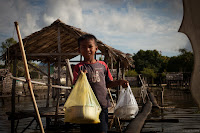One of the darkest pages of the history of Cambodia are the "three years, eight months and twenty days" of the Kampuchea Democratic Republic, that between 1975 and 1979 brought to death over 1,5 millions people.
 |
| Photo of the inside court (Wikipedia ©) |
Most of the evidences of this atrocity can be seen at the Tuol Sleng museum, also known as S-21, an old school used by the Khmer Rouge as an high security prison at first and then transformed into the main custody camp and torture structure of the country, where over 17,000 people - rebels, intellectuals as well as some foreigners - have been imprisoned and killed during the regime.
It is located on street 113 and the entrance costs $2. The complete tour will take around one hour, and is something that I strongly recommend if you want to understand something more about the recent history of the country. It is, by the way, something very strong. If you are sensibles, maybe you should consider the idea of not going there.
The structure is divided into 4 buildings that surround a central court, where today you will find the 14 graves of the very last victims of Pol Pot's army, killed when the Vietnamese army was liberating Phnom Penh.
The very first thing that you will see entering the site, is a list of the rules (in a literal translation from khmer) that had to be followed by prisoners:
 1. You must answer accordingly to my question. Don’t turn them away.
1. You must answer accordingly to my question. Don’t turn them away.
2. Don’t try to hide the facts by making pretexts this and that, you are strictly prohibited to contest me.
3. Don’t be a fool for you are a chap who dare to thwart the revolution.
4. You must immediately answer my questions without wasting time to reflect.
5. Don’t tell me either about your immoralities or the essence of the revolution.
6. While getting lashes or electrification you must not cry at all.
7. Do nothing, sit still and wait for my orders. If there is no order, keep quiet. When I ask you to do something, you must do it right away without protesting.
8. Don’t make pretext about Kampuchea Krom in order to hide your secret or traitor.
9. If you don’t follow all the above rules, you shall get many lashes of electric wire.
10. If you disobey any point of my regulations you shall get either ten lashes or five shocks of electric discharge.
Building A
Is the first building that you will visit if you follow the direction of the tour. It was the area where tortures took place. Some of the instruments, as well as the camp bed where prisoners were enchained, have been left there. On the wall, the photos of the last tortured bodies that have been founded by the Vietnamese. Traces of blood are printed indelibly on the floor.
Detention cells can be founded as well.
Building B
The second building has been used as exposition site: all the photos of the victims can be founded here (often before and after the tortures), as well as the witnesses of the survived. Many panels have been installed to explain the history of the regime and of the camp.
Building C
The third, was a detention one. Small cells (1x2m), made in bricks or in wood. Try to get inside and to close the door. If you feel some empathy, you can imagine how hard would have been to be forced to live in there. The whole building is covered by barbed wire, to avoid prisoners to commit suicide.
Building D
Torture instruments can be founded here, together with some witnesses and photos of the victims.
 If you want to run away from the chaos of Sihanoukville, just a few kilometers away you will find Otres Beach, a small touristic village totally built on the seaside. Guesthouse are the only "buildings" of the areas, if we can call them so. Most of have small bungalows right on the beach, built in wood and bamboos, from where you can enjoy the stunning show of the sun setting behind the sea.
If you want to run away from the chaos of Sihanoukville, just a few kilometers away you will find Otres Beach, a small touristic village totally built on the seaside. Guesthouse are the only "buildings" of the areas, if we can call them so. Most of have small bungalows right on the beach, built in wood and bamboos, from where you can enjoy the stunning show of the sun setting behind the sea. Around Otres you won't find much to do, but one thing that I highly recommend is the tour of the small islands in front of it. If you have any bases in sailing, then you can rent a small sailing boat for $30 to $70 for an half day and reach the islands by your own. In alternative, you can just take one of the many motorboat offered by locals. It will take you no longer than an hour to get to the closest, even with bad wind.
Around Otres you won't find much to do, but one thing that I highly recommend is the tour of the small islands in front of it. If you have any bases in sailing, then you can rent a small sailing boat for $30 to $70 for an half day and reach the islands by your own. In alternative, you can just take one of the many motorboat offered by locals. It will take you no longer than an hour to get to the closest, even with bad wind.

































